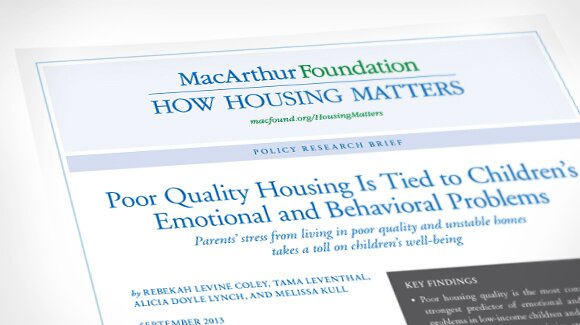The MacArthur Foundation asked us to write a series of for , an initiative that explores how housing affects education, employment, and physical and mental health. Each brief synthesizes the study’s essential findings to help inform policy discussions. We also worked closely with foundation staff and leading housing scholars to develop policy implications from the results of the research funded as part of the MacArthur Foundation’s $25 million investment in this area.
Policy Brief
Client:

Poor Quality Housing Is Tied to Children’s Emotional and Behavioral Problems
By Barbara Ray
Growing up in a cold and damp home with cardboard on the windows in deep winter, or in a home with leaking roofs, exposed wiring, and roaches or mice is an enduring memory for many who grow up in those conditions. Although these circumstances leave their mark on memory, until recently, it was difficult to know whether they left their mark in other areas of a child’s life, like emotional and behavioral functioning or school success. A recent study by Rebekah Levine Coley and colleagues begins to answer that question. In a rigorous study, Coley and colleagues find that, indeed, housing quality—and to a lesser extent housing stability and affordability—matter to young people’s well-being.
This brief examines how housing characteristics matter to children and families’ well-being. Among the various possibilities tested, poor housing quality was the most consistent and strongest predictor of emotional and behavioral problems in low-income children and youth. It also had a sizable association with school performance among older youth. Housing affected children because the stress of living in unhealthy and unsafe conditions affected parenting.
Advantages of the Current Study
Past research has identified several aspects of housing that are thought to be associated with children’s development. Researchers, for example, have found that substandard housing—exposed wiring, peeling lead paint, rodent infestation, and the like—may contribute to physiological stress in children, inhibiting their emotional stability and learning. Similarly, residential instability may interrupt peer and school networks, impeding academic and behavioral success. If housing costs are unaffordable, families may be forced to limit other valuable investments, such as extra- curricular activities, and even other basic necessities such as food and medical care, all of which are important to healthy development. On the other hand, owning one’s home or receiving government subsidies may increase family stability and social connections, helping to improve children’s school success.
Although past research has identified many associations between housing and children’s well-being, studies have tended to assess only a single dimension of housing at a time even though housing characteristics do not occur in isolation. In addition, the very characteristics that allow a parent to afford higher quality and more stable housing—a good job, steady income, family stability, perseverance, and organization—might be the same characteristics that influence children’s outcomes.
The current study untangled many of these issues. The analysis takes a comprehensive view of housing, assessing quality, stability, affordability, ownership, and subsidy receipt status. It carefully adjusts for characteristics of parents and families that are likely associated with housing contexts. It addresses multiple aspects of children’s well-being, including their cognitive, emotional, and behavioral functioning. Finally, the analysis includes young children, school-age children, and adolescents.
